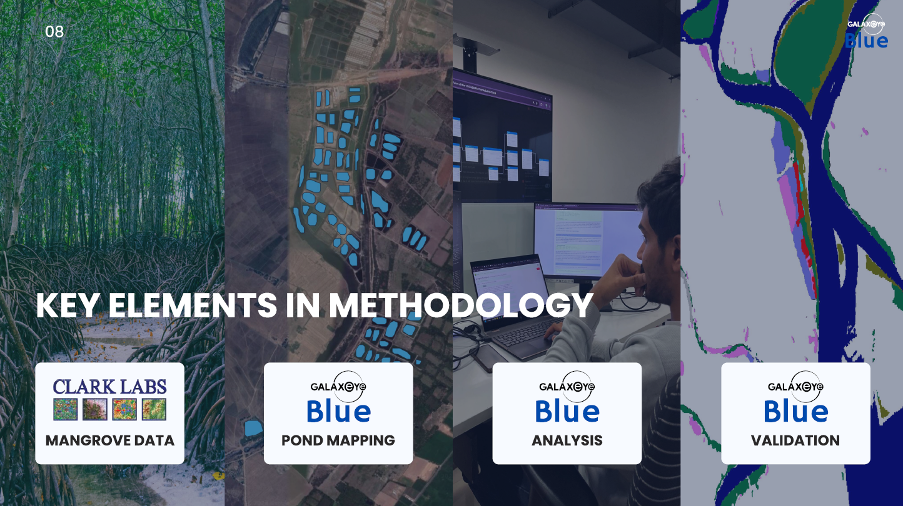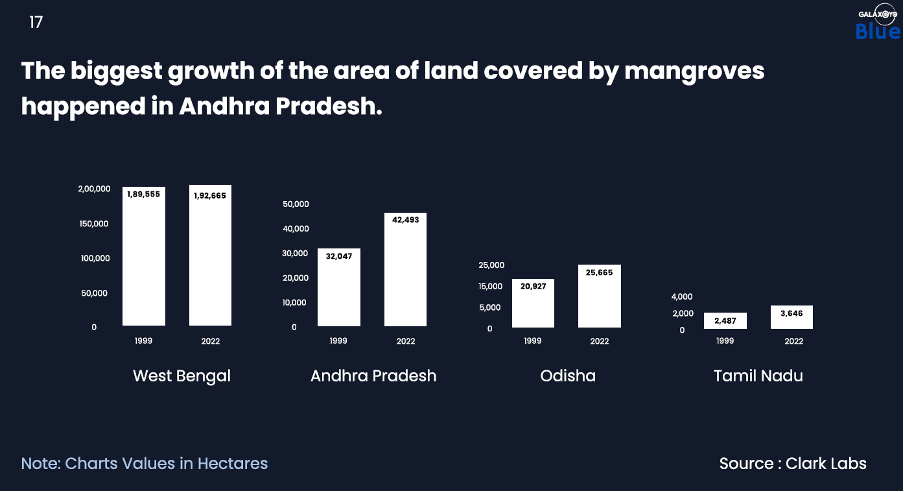Recent reports have accused India of continuous, widespread mangrove destruction through its expansion of shrimp farming on the country's east coast. But is this claim a fair one? Satellite imagery analysis by Indian space tech start-up GalaxEye Space using its own aquaculture pond database and Clark Labs' mangrove database (see Image 1) prove these accusations to be unfounded. Their analyses show that from 1999 to 2022, only 0.3% of the total land covered with mangroves was converted into fish and shrimp ponds. What's more, the total net area covered by mangroves has actually increased by 8%.
In this commentary, I will debunk the myth that the recent expansion of shrimp farming operations has led to "continuous" and "widespread" mangrove destruction, and will back it up with evidence.
In 2024, the Shrimp Blog is supported by: Inve Aquaculture, Taprobane Seafoods, DSM-Firmenich, Zeigler Nutrition, Bioiberica, Megasupply, American Penaeid, Omarsa and eFishery.


Credit: GalaxEye Space

Understanding Mangrove Conservation in India Today
Strengthened conservation efforts by India's government that started in the early part of the 21st century with a strengthened forest act and the implementation of the Coastal Aquaculture Act, combined with the overall public awareness about the significance of mangrove forests for the country's ecological health mean that rather than declining, the total area covered by mangroves on the eastern coast has actually increased by 8%. So how did this happen?
India strongly supports the Ramsar Convention on Wetlands, and has the most significant number of Ramsar sites in South and Southeast Asia. Besides that, the Indian government has made the protection of wetlands in general, and the protection of mangroves in particular, a priority. India's finance minister announced two major programs for mangrove plantation and wetlands conservation in the country's latest annual budget for 2023-24. One initiative, "Building on India's Success in Afforestation, Mangrove Initiative for Shoreline Habitats & Tangible Incomes (MISHTI)," will entirely focus on mangrove plantation along the coastline and in salt pan lands, wherever feasible. Some funds that the new program draws from were allocated for afforestation efforts to compensate for diverting forests for non-forest use. Successful conservation and afforestation efforts depend greatly on cooperation and the co-management of mangrove habitats with local communities, civil society, and other actors in the coastal ecosystem, such as the shrimp industry.
One of the organizations working on mangrove conservation and afforestation is the Swaminathan Foundation. This organization has been working on this task from 1993 onwards and claims to have restored 2025 ha of mangroves. On the eastern coast, the organization has been working in Tamil Nadu between 1993-2018 and has restored 900 ha of mangroves. In Andhra Pradesh, it worked on mangrove conservation between 1999-2002 and 2017-2021 and restored 860 ha of mangroves. In Odisha, its activities took place between 1996-2004, and it restored 240 ha of mangroves. Read more about the organization's work in its report on "Restoring mangroves ecosystems saves the coastline and community".

The High-Level Facts About Mangroves and Shrimp Farms on India's East Coast
The majority of India's shrimp farms and mangroves are concentrated on the east coast. For this reason, GalaxEye Space has limited its analysis to the east coast.
The primary mangrove forests on the east coast are the Sundarbans (West Bengal), the Bhitarkanika Mangroves (Odisha), the Godavari-Krishna Mangroves (Andhra Pradesh), and the Pichavaram Mangroves (Tamil Nadu). Smaller patches are also found in other parts of the east coast's deltas and river estuaries. Shrimp farming is concentrated in Andhra Pradesh, with significant farming activities also being present (in order of significance) in West Bengal, Odisha, and Tamil Nadu.

Credit: GalaxEye Space
It's true to say that India's east-coast shrimp farms and mangroves compete for scarce land along the coastal creek- and riversides. Data on mangroves from Clark Labs and analysis using GalaxEye Space's proprietary pond database show that between 1999 and 2022, the land covered by fish and shrimp ponds expanded by 87%, and that the total area covered by mangroves increased by 8% (see Image 3). In 2022, around 385,000 ha on the east coast was covered by fish and shrimp ponds, and around 260,000 ha was covered by mangroves.


Credit: GalaxEye Space
Amidst strong conservation and afforestation efforts, as well as natural expansion of mangrove forests, the total area of land covered by mangroves increased from 1999-2022, a period of 23 years, by 20,000 ha or 8%. As 9,550 ha of land was lost during the same period, the gross increase of mangroves was even close to 30,000 ha.
While the total area under mangroves increased, also some mangroves were lost. The majority of mangroves during this 23 year period was lost for a variety of reasons: because of climate change, tropical storms, industry expansion, and other agricultural activities to name a few. These reasons, according to GalaxEye Space's analysis, resulted in a loss of around 8,800 ha of mangrove forests.
Over the same 23-year period, mangrove to fish or shrimp pond conversion was limited to an area of 750 ha. To put this in perspective, this figure represents just 0.3% of the total land covered by mangroves and only 0.2% of the total fish and shrimp pond area. Placing these figures in context makes claims accusing India's shrimp industry of continuous and widespread mangrove destruction not only unfair and misrepresentative, but also unfounded.

A closer look at two of the major states where mangroves and shrimp-farming exist side-by-side: Andhra Pradesh and West Bengal
The state of Andhra Pradesh, is home to some major rivers: The Godavari, The Krishna, The Pennar, and The Vamsadhara. The majority of the region's mangrove forests can be found in the estuaries of these rivers, but they also occur in smaller patches along the coastline. Despite the rapid expansion of the shrimp industry, and around 450 ha of mangroves that despite forest conservation regulations were converted to fish and shrimp ponds, the area covered by mangroves in Andhra Pradesh grew from 32,047 ha in 1999 to 42,493 ha in 2022, an increase of 33%. This increase is a strong confirmation of conservation and aggressive afforestation efforts of federal and state level authorities.
The majority of India's mangroves are located in the state of West Bengal, which is home to around 192,665 ha of mangroves and a portion of one of the most famous and largest mangrove forests in the world: the Sundarbans. Traditional shrimp farms have been active since the 1980s around the Sundarbans. These are large, multi-hectare ponds where farmers grow shrimp in low densities. The Sundarbans are now well preserved, and no significant destruction of mangroves due to shrimp farming expansion has occurred between 1999 and 2022. This is slightly different in other coastal districts in West Bengal, where more intensive shrimp farming has expanded recently, and, despite local regulations, some mangrove conversion has occurred. The total land covered by mangroves in West Bengal slightly increased from 189,555 ha to 192,665 ha. This, again, illustrates the success of India's mangrove conservation and afforestation efforts.

Why Look at 1999 Onwards
You might ask why, in this commentary, I've chosen to focus my attention on the period after 1999. Indeed, mangrove deforestation also occurred before 1999. But the COP 7 Conference in May 1999 was a key moment in the conservation of mangrove forests: many governments made firm commitments to mangrove conservation when the Ramsar Convention was approved.
In the period before 1999, there was little consensus about protecting mangroves. Mangrove conservation wasn't high on governments' agendas, and mangrove conversion in general was, indeed, a more widespread practice, including through aquaculture expansion.
Organizations like third-party certification body Aquaculture Stewardship Council (ASC) also recognize 1999 as a benchmark moment in wetland conservation. For farms built after 1999, ASC's Standard prohibits the clearing of mangrove forests for the purpose of building shrimp farms. Farms that were built before 1999, however, on land that was previously covered by mangroves must rehabilitate 50% of the area cleared for the farm. ASC, does, however, also recognize that there may also be practical reasons for using 1999 as a key moment—farms might have changed ownership multiple times in the 25-year period, making it challenging to hold someone in particular/a particular company to account for previous deforestation that occurred. I, too, support this logic and therefore exclude the period before 1999 from the scope of this analysis.
What's more, I feel that looking back more than twenty years does not feel particularly useful or relevant when we are talking about the accusations that are circulating today of "continuous" and "widespread" mangrove deforestation in India. My personal view is that, when it comes to who is being accused, we should take the historical context into consideration, especially when making serious claims against particular players—in other words, it's hard to hold the industry's current leadership to account for practices that occurred such a long time ago, when the industry was still in its relevant infancy. These constitute practices that today's leadership couldn't influence or control, and that have since become highly regulated.

Industry Coexisting with Vital Ecosystems
India is one of the world's largest shrimp producers and is home to some of the world's most significant mangrove habitats. While the shrimp industry is vital for India because of its economic significance and the number of jobs it creates, mangroves are essential for coastal protection, biodiversity, and carbon sinking. It's in the interest of the industry and the wider Indian society that the shrimp industry and the country's mangrove habitats not only coexist but also flourish.
If we take a moment to consider the market challenges the Indian industry faces in the wake of these claims, committing itself to supporting increased mangrove conservation and afforestation projects could significantly enhance its market image and consumer perception. According to Indian legislation, companies must spend a 3% of their three-year trailing average net profit on corporate social responsibility (CSR) activities; mangrove conservation projects would be a good place to start for some of the country's shrimp exporters in light of this situation.
While some deforestation has indeed happened over the past 25 years, contrary to common belief the numbers show that the scale of conversion does not justify the accusations being put on the Indian shrimp industry: as proved in this analysis, the industry's impact has actually been quite limited. In my view, these claims are, therefore, unfounded, unfair and unjust. Even more, while the shrimp industry expanded rapidly during this period, the land covered by mangroves increased significantly, by more than 20,000 ha.
It's essential to spread this message within the industry, to retailers, and to consumers worldwide: accusations like this don't only damage the Indian shrimp industry but the global shrimp industry more broadly. I'm asking you to help me spread this message.
Would you like more information about this analysis? Contact the author at willem@shrimpinsights.com.
About Shrimp Insights
Shrimp Insights is the consultancy and publications firm of Willem van der Pijl. The organization publishes blogs and reports about the industry, and works for a range of clients within the shrimp industry.
About GalaxEye Space
GalaxEye Space is a DeepTech startup focused on building India's first private constellation of Earth Imaging Satellites. Founded by IIT Madras alumni, GalaxEye Space aims to revolutionize various industries by providing precise, real-time geospatial intelligence. GalaxEye Blue, the company's flagship product for aquaculture, exemplifies their commitment to innovation and sustainability.

